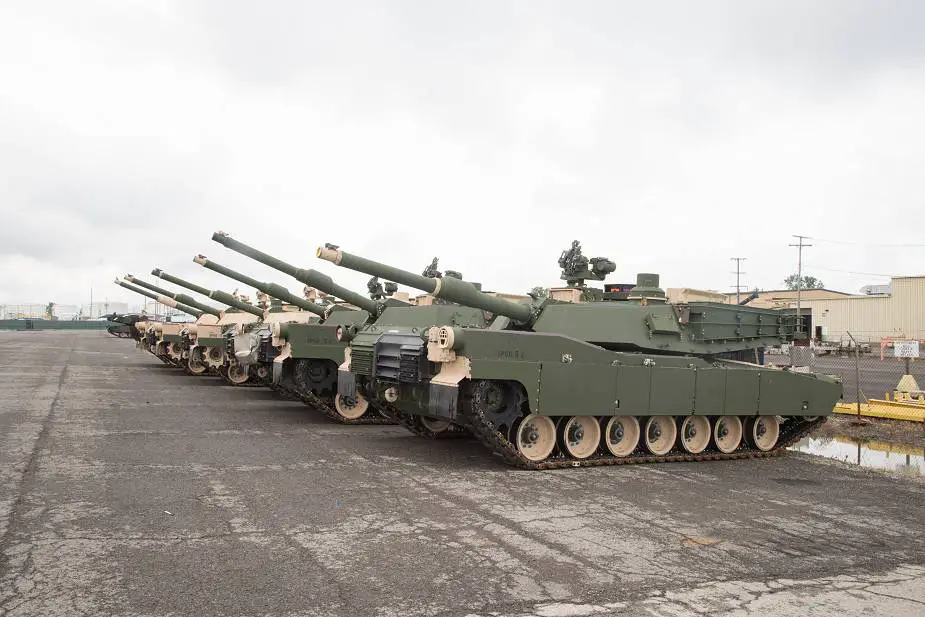M1A2 Abrams main battle tanks need solutions to alleviate obsolescence issues
During the annual Michigan Defense expo that was held from 20 to 21 May 2020, the U.S. Tank-automotive and Armaments Command (TACOM) has requested the defense industry to provide solutions to alleviate obsolescence issues of M1A2 Abrams main battle tanks.
Follow Army Recognition on Google News at this link

M1A2 SEP V3 ready to be delivered to the U.S. army. (Picture source Twitter account Nicholas Drummond)
The M1A2 SEP V3 or M1A2C is the latest modernization variant in the M1A2 Abrams tanks family. The M1A2 SEPv3 improvements include the introduction of the joint tactical radio system and improved power generation and distribution with an increased margin to accept future technologies, counter remote-control improvised bomb electronic warfare capability, ammunition data link to program the M829A4 Advanced Kinetic Energy and Advanced Multi-Purpose rounds, an auxiliary power unit to power onboard systems without running the engine, and armor upgrades.
According to the US Army Weapon Systems Handbook, the first M1A2C main battle tanks were delivered to the US Army and the development of the M1A2D will continue until 2023. The Abrams fleet consists of two variants: the M1A1 SA (Situational Awareness) and the M1A2 SEP (System Enhancement Program) version 2.
M1A1 SA: Currently in Sustainment and slated for divestment between the Fiscal Year 2020 (FY20)-FY25, this variant has a single second-generation Forward-Looking Infrared (FLIR) sight and analog architecture. While less capable, it is just as survivable and maneuverable as the more modern variants. The M1A1 SA has Blue Force Tracker — a digital command-and-control system that gives commanders information about their location relative to friendly forces — and powertrain improvements.
M1A2 SEPv2: All M1A2 tanks have two sights, a gunner’s and commander’s sight, which increase the tank’s lethality by enabling a hunter/killer technique — as the gunner destroys targets, the commander can simultaneously survey the battlefield for the next threat. All M1A2s also have digital architectures, which facilitate future upgrades, allow interoperability and ease the maintenance burden. Other upgrades include Common Remotely Operated Weapon Station – Low Profile, an ammunition data link to fire improved rounds, and 12 batteries for longer silent watch. Program Manager Abrams has integrated the Trophy Active Protection System (APS) on the M1A2 SEPv2.
M1A2C: The next version of the Abrams tank is in Production and finalizing testing. This version rectifies many of space, weight and power issues identified during Operation Iraqi Freedom and will be the foundational variant for all future incremental upgrades. In addition to having improved survivability, the Abrams M1A2C can host any mature technology the Army deems operationally relevant. Improvements focus on increasing the electrical power margin, Vehicle Health Management Systems, integrated counter-improvised explosive device protection, a new Auxiliary Power Unit, embedded training and an ammunition data link. It is the most reliable Abrams tank ever produced, will decrease the Army’s logistic burden, and leads the Army in enterprise-level connectivity to maintenance and supply systems.
M1A2D: The most modern Abrams tank has started development; the cornerstone technology is the third generation (3GEN) FLIR, which will provide tank crews much greater lethality. The 3GEN FLIR will be an upgrade to both sights and will be common with other combat platforms. With the upgrade, the Abrams will integrate a color camera, Eye-safe Laser Range Finder and a cross-platform laser pointer to facilitate multi-domain battle into the commander’s sight. In addition to a lethality upgrade, the M1A2D will include full-embedded training to maximize crew proficiency of the system. This program began early enough to on-board any technology the Army deems critical to the future battlefield to include artificial intelligence, autonomy, APS, or advanced sensors.


























